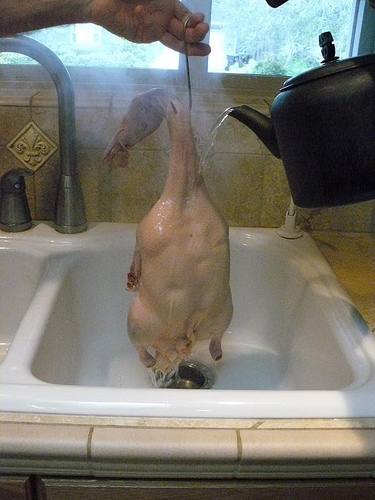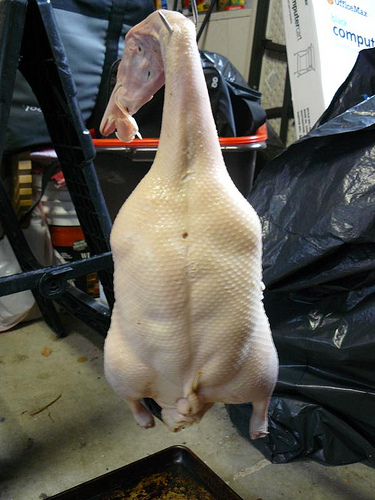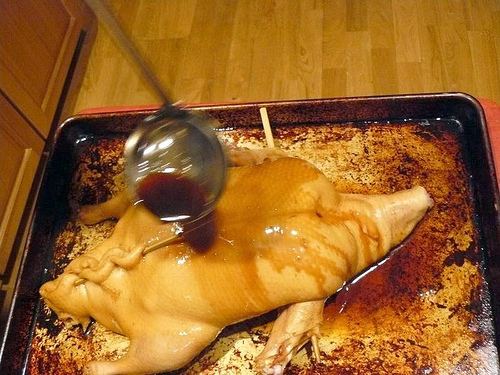
I hope you didn’t blow up a duck over the weekend and wait for me to let you know what to do with it next! If we were together in real time, I would have blown up the duck with my exercise ball pump and then moved right into this next and equally crucial step in preparing Peking duck: scalding the skin.
Why scald the skin? It tightens up the pores, facilitating drying and crisping. It's a step that is as important as the initial blowing up of the duck. I’ve read several Peking duck recipes that tell cooks to do things like “clean the duck well before dousing it with a pot of boiling water, then hang it up to dry thoroughly – either leave it in a drafty place overnight or use a fan heater or hairdryer to speed up the process.” Deh-Ta Hsiung wrote that in Chinese Regional Cooking (1979) and frankly, it was rather intimidating. Modern recipes add a touch of practical advice by telling you to use a meat hook. As you can imagine, there are some rather cruel steps to be taken here, namely: 1) Stick a metal meat hook into the duck’s neck; 2) pour boiling water all over its body; and 3) hang it up to dry.
Yours truly has a set of meat hooks purchased years ago from a Chinese restaurant supply shop. It’s nothing but a heavy-duty “S” hook with a very sharp end. I’d been saving those hooks for char siu pork and any other Chinese-style roasting projects such as this one. Doing this step in a restaurant kitchen is probably easy as there are likely more places to hang the duck up and ceremoniously throw water at it. And like I’ve seen in Hong Kong, you can hang the duck out in a back alley to dry.
In my home kitchen, I decided that scalding the duck should be a two-person job, like pumping up the duck. Projects like homemade Peking duck takes a fair amount of thinking before doing. Rory and I paused between pumping and scalding to discuss strategy and safety. Our final game plan included sticking the hook through the neck, a couple inches below the head so as to have the broadest base possible. I’m not good with duck anatomy so it was quite hard (literally) to force the meat hook through just right. Holding the duck over the sink, we poured a kettle of just-boiled water onto the duck instead of ladling or dousing the poor thing. The kettle allows you to control the flow of water and prevents potential domestic disasters. Done over the sink, the scalding quickly goes down the drain.
Scalding the duck made its skin taught, somewhat smooth but also goose-bumpy. After scalding, the duck has to hang to dry before it gets rubbed with a colorant of mostly diluted maltose or honey. Rory diligently set up two sawhorses in the garage, with a metal extension rod between them:

We hung the duck and after 15 minutes, it rolled off the sawhorse support with a thud and we ran back into the garage to fish the duck from the roasting rack that it fell upon. I suggested hanging it on the garage door opener mechanism which is about 8 feet high, but my husband didn’t want to risk opening the garage and having a poultry accident.
I also didn’t like letting raw poultry sit out and the duck kinda got gamey smelling. In the end, I stuck the duck on a roasting rack in the fridge, which I imagined, simulated a very cold, dryish environment. I left the duck uncovered overnight. That was duck #2 and I eventually deep-fried the duck for the fragrant and very crispy Sichuan duck. I experimented with the blowing and scalding to see if those techniques did anything for the deep-fried duck and they didn’t.
Last week’s duck #3 was destined to be roasted as Peking duck. I thought about it more and got smarter. Forget the hook and hanging. Following a tip in the 1986 cookbook, Ken Hom’s Chinese Cookery, I decided to scald and tan the duck in one step. Hom, a chef, TV personality and author, has you simmer the following for 20 minutes:
3 tablespoons honey
3 tablespoons dark soy sauce [I used 1 ½ tablespoon dark, 1 tablespoon light soy sauce as his duck was a brown-black color]
1 lemon, sliced ¼ inch thick
⅔ cup Shaoxing rice wine or dry sherry
4 cups water
Then he instructs you to ladle the mixture over the duck, as if to bathe it. I put the blown up duck (remember it has not been scalded) on a baking sheet. Then I ladled the hot seasoning liquid over the duck. With each progressive coating, the duck got darker and its skin tightened. I turned the duck over and coated the back too. The fact that the duck laid in a pool of liquid didn’t matter. When done, the duck skin was smooth and a lovely tan color.

To dry it, I put the duck on a roasting rack set in a roasting pan and slid the whole thing in the fridge. Uncovered, the duck dried out slowly for 2 nights.

Each day, the duck got a little darker – with at the end what looked like an enviable San Tropez, Ban de Soleil kind of golden tan (above photo). When I touched the skin, it felt dry with slight moisture, just a tad tacky. As I monitored the duck’s progress over the course of days, I pondered the roasting process.
Related homemade Peking duck links:
- Step 1: How to blow up a duck
- Step 3: How to roast the duck
- Chinese steamed rolls (on Asiandumplingtips.com)
- Fragrant and crispy duck recipe (deep-fried Sichuan alternative to Peking duck)
- Fragrant and very crispy duck recipe (another version of the deep-fried duck)

















sunflower says
You can bottle and sell that tanning concoction. May work better than San Tropez.:)
Looking promising. when is the roasting day?
Are you making the duck pancakes too. I have a recipe on the blog.
TripleScoop says
Very interesting reading. It definitely a labor of lover it seems like.
Andrea Nguyen says
Ha! We'll roast in a couple of days.
Sunflower -- you have a great repository of recipes here:
http://sunflower-recipes.blogspot.com/
Christine@ Fresh Local and Best says
I will have to try this method of scalding a duck. In previous trials, I had a huge stock pot of boiling water, and dipped the duck about dozen times or until the skin plumped up.
Andrea Nguyen says
Christine -- your method sounds good too. This approach sort of replicates the dousing concept!
Shropshire Plumber says
Thank you so much for this, I'm planning on doing this at the weekend for my husband and I. Thanks for the detailed advice.
Shox NZ Shoes says
important as the initial blowing up of the duck. I’ve read several Peking duck recipes that tell cooks to do things like “clean the duck well before dousing it with a pot of boiling water, then hang it up to dry thoroughly – either leave it in a drafty place overnight or use a fan heater or hairdryer to speed up the process.” Deh-Ta Hsiung wrote that in Chinese Regional Cooking (1979) and frankly, it was rather intimidating. Modern recipes add a touch of practical advice by telling you to use a meat hook. As you can imagine, there are some rather cruel steps to be taken here, namely:
1) Stick a metal meat hook into
scald injury says
When you call our free scald injury compensation advice service, you will be speaking directly with a solicitor who has many years experience with compensation claims of this nature. Our solicitor will appreciate the physical trauma you have recently been through and understand your concerns about the long term effects of your scald injury.
cook lamb says
Don't know if it's that my tastebuds got used to something different used here in San Francisco but will definitely try the the roast mixture.
Justin Bieber Shoes says
Thanks for your good advice. I agree. The more people, the merrier. More weight makes for a faster ride. Thanks David, good advice. We're actually already starting to work.
Canada Goose says
Nothing great was ever achieved without enthusiasm.
irma says
i have good time reading about your quest to conquer the duck 🙂
Thank you Andrea, you have new fan 🙂
marlon says
this recipe very delicious! I will have to try this method of scalding a duck.